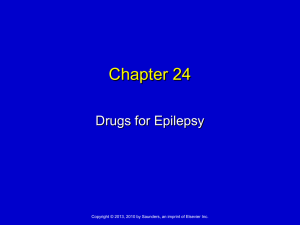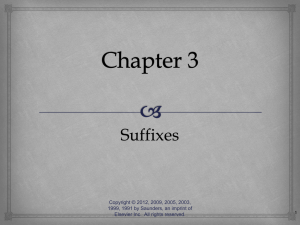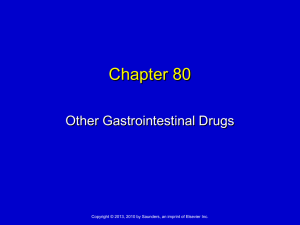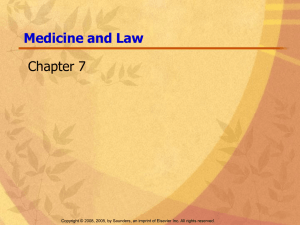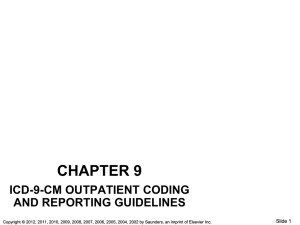Cont`d
advertisement
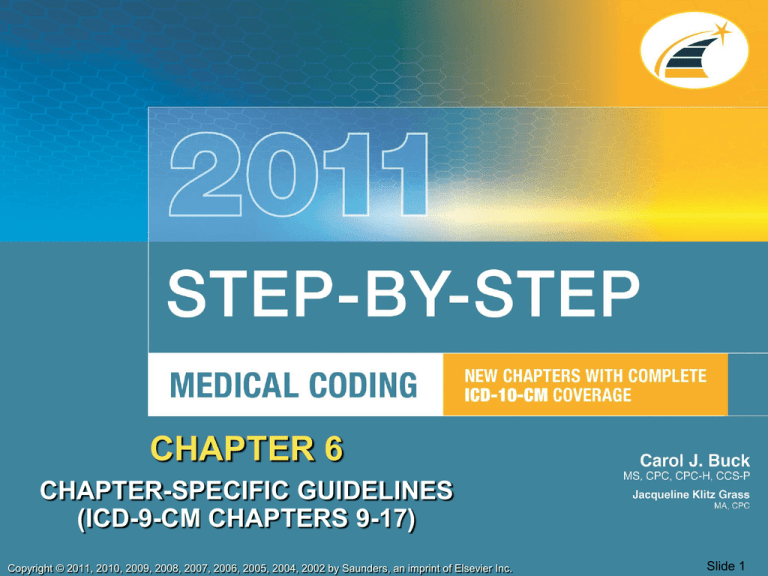
CHAPTER 6 CHAPTER-SPECIFIC GUIDELINES (ICD-9-CM CHAPTERS 9-17) Copyright © 2011, 2010, 2009, 2008, 2007, 2006, 2005, 2004, 2002 by Saunders, an imprint of Elsevier Inc. Slide 1 Chapter 9 • Diseases of Digestive System – Mouth to anus and accessory organs – Extensive subcategories • 574 Cholelithiasis (10 subcategories) • Each has fifth digit subclassification – Presence of hemorrhage associated with diseases in this chapter • Query provider if documentation is not clear Copyright © 2011, 2010, 2009, 2008, 2007, 2006, 2005, 2004, 2002 by Saunders, an imprint of Elsevier Inc. Slide 2 Chapter 10 • Diseases of Genitourinary System • Commonly used codes – Urinary tract infection (599.0) – Inflammation of prostate (601.X) – Disorders of menstruation (626-627) & breast (610-612) • Use additional code to identify organism Use additional codes to identify lower urinary tract symptom Copyright © 2011, 2010, 2009, 2008, 2007, 2006, 2005, 2004, 2002 by Saunders, an imprint of Elsevier Inc. Slide 3 Chapter 11, Complications of Pregnancy, Childbirth, and the Puerperium • Extensive multiple coding with many fifth digit assignments and notes • Chapter 11 codes take precedence over codes from other chapters • Admission for pregnancy, complication – Obstetric complication = first-listed diagnosis Copyright © 2011, 2010, 2009, 2008, 2007, 2006, 2005, 2004, 2002 by Saunders, an imprint of Elsevier Inc. Slide 4 Section I.C.11. Complications of Pregnancy, Childbirth, and Puerperium • Chapter 11 codes • Mother’s medical record (600 series codes) • Not on newborn medical record (Newborn, 700 series codes) (Cont’d…) Copyright © 2011, 2010, 2009, 2008, 2007, 2006, 2005, 2004, 2002 by Saunders, an imprint of Elsevier Inc. Slide 5 Section I.C.11. Complications of Pregnancy, Childbirth, and Puerperium (…Cont’d) • Mother’s record – Outcome of delivery code (V27.0-V27.9) when delivered Copyright © 2011, 2010, 2009, 2008, 2007, 2006, 2005, 2004, 2002 by Saunders, an imprint of Elsevier Inc. Slide 6 Section I.C.11.a. General Rules for Obstetric Cases • Not all encounters are pregnancy related – Example, pregnant woman, broken ankle • Broken ankle • V22.2 Pregnant state incidental must be documented in medical record treated condition not affecting pregnancy Copyright © 2011, 2010, 2009, 2008, 2007, 2006, 2005, 2004, 2002 by Saunders, an imprint of Elsevier Inc. Slide 7 Section I.C.11.a.4. Fifth Digit • All categories EXCEPT 650 (Normal delivery) • Requires fifth digit for: – Antepartum – Postpartum – Delivery Copyright © 2011, 2010, 2009, 2008, 2007, 2006, 2005, 2004, 2002 by Saunders, an imprint of Elsevier Inc. Slide 8 Codes 640-676.9 Share Fifth-Digit Subclassification • Denotes current episode of care – 0 Unspecified as to episode of care or not applicable – 1 Delivered, with or without mention of antepartum condition – 2 Delivered, with mention of postpartum complication – 3 Antepartum condition or complication – 4 Postpartum condition or complication Copyright © 2011, 2010, 2009, 2008, 2007, 2006, 2005, 2004, 2002 by Saunders, an imprint of Elsevier Inc. Slide 9 Section I.C.11.b. Selection of Principal Diagnosis—Obstetric • No delivery: Principal diagnosis = principal complication • >1 complication, sequence any first (Cont’d…) Copyright © 2011, 2010, 2009, 2008, 2007, 2006, 2005, 2004, 2002 by Saunders, an imprint of Elsevier Inc. Slide 10 Section I.C.11.b. Selection of Primary Diagnosis (…Cont’d) • Routine prenatal visits no complications: – V22.0, Supervision, normal first pregnancy or – V22.1, Supervision, other normal pregnancy – Always primary diagnosis • Prenatal outpatient visits for high-risk pregnancies: – V23, Supervision of high-risk pregnancy (V23.X) Copyright © 2011, 2010, 2009, 2008, 2007, 2006, 2005, 2004, 2002 by Saunders, an imprint of Elsevier Inc. Slide 11 Section I.C.11.c.1. Fetal Conditions Affect Mother • Codes from Categories 655 and 656 • Assign only if known or suspected fetal abnormality affects management of the mother • Requires additional diagnostic studies, observation, special care or termination of the pregnancy • The existence of a fetal condition alone does not justify reporting these codes Copyright © 2011, 2010, 2009, 2008, 2007, 2006, 2005, 2004, 2002 by Saunders, an imprint of Elsevier Inc. Slide 12 Section I.C.11.c.2. In Utero Surgery • When surgery is performed on the fetus, report a code from Category 655 identifying the fetal condition • No code from Chapter 15, perinatal codes, should be used on the mother’s record to identify fetal conditions • Surgery performed in utero on the fetus is still coded as an obstetric encounter Copyright © 2011, 2010, 2009, 2008, 2007, 2006, 2005, 2004, 2002 by Saunders, an imprint of Elsevier Inc. Slide 13 Section I.C.11.d. HIV Infection in Pregnancy, Childbirth, Puerperium • Patient admitted during this period because of an HIV-related illness should receive – a principal code of 647.6x – followed by 042 • Patient admitted with asymptomatic HIV status should be reported – 647.6x – V08 Copyright © 2011, 2010, 2009, 2008, 2007, 2006, 2005, 2004, 2002 by Saunders, an imprint of Elsevier Inc. Slide 14 Section I.C.11.e. Current Conditions Complicating Pregnancy • Assign a code from Category 648.x for patient with current condition that affects management of the pregnancy, childbirth or the puerperium • Use additional secondary code from other chapters to identify conditions Copyright © 2011, 2010, 2009, 2008, 2007, 2006, 2005, 2004, 2002 by Saunders, an imprint of Elsevier Inc. Slide 15 Section I.C.11.f. Diabetes Mellitus in Pregnancy • Significant complicating factor in pregnancy • Diabetic pregnant patients should be assigned code 648.0x AND • A secondary code from Category 250 to identify type of diabetes • Code V58.67, Long-term (current) use of insulin should also be reported if appropriate Copyright © 2011, 2010, 2009, 2008, 2007, 2006, 2005, 2004, 2002 by Saunders, an imprint of Elsevier Inc. Slide 16 Section I.C.11.g. Gestational Diabetes • Occurs in second and third trimester in women who were not diabetic prior to pregnancy • Can cause complications in pregnancy similar to those of pre-existing diabetes • Puts women at greater risk of developing diabetes after the pregnancy (Cont’d…) Copyright © 2011, 2010, 2009, 2008, 2007, 2006, 2005, 2004, 2002 by Saunders, an imprint of Elsevier Inc. Slide 17 Section I.C.11.g. Gestational Diabetes (…Cont’d) • Report 648.8x • NEVER report codes 648.0x and 648.8x together • Code V58.67, Long-term (current) use of insulin should also be reported if gestational diabetes is being treated with insulin Copyright © 2011, 2010, 2009, 2008, 2007, 2006, 2005, 2004, 2002 by Saunders, an imprint of Elsevier Inc. Slide 18 Section I.C.11.h. Normal Delivery, 650 • No complications, principal diagnosis = 650 • With complications = NOT 650 • V27.0 (Single liveborn) – Only outcome for 650 (Normal Delivery) • Normal delivery with resolved antepartum condition = 650 Copyright © 2011, 2010, 2009, 2008, 2007, 2006, 2005, 2004, 2002 by Saunders, an imprint of Elsevier Inc. Slide 19 Section I.C.11.i.1. Postpartum and Peripartum Periods • After delivery and continues for 6 weeks • Peripartum period – Last month of pregnancy to five months postpartum Copyright © 2011, 2010, 2009, 2008, 2007, 2006, 2005, 2004, 2002 by Saunders, an imprint of Elsevier Inc. Slide 20 Section I.C.11.i.2,3,4 Postpartum Complications • Any complication occurring within the 6-week period • Complications occurring after the 6-week period may be reported with Chapter 11 codes, if the provider documents they are pregnancy related • Complications occurring during the same admission as delivery are reported with fifth digit “2”; subsequent admissions/encounters with fifth digit “4” Copyright © 2011, 2010, 2009, 2008, 2007, 2006, 2005, 2004, 2002 by Saunders, an imprint of Elsevier Inc. Slide 21 Section I.C.11.i.5 Care following delivery outside hospital • If delivered prior to admission – In ambulance – At home – In ED • DO NOT CODE delivery • Code any postpartum care Copyright © 2011, 2010, 2009, 2008, 2007, 2006, 2005, 2004, 2002 by Saunders, an imprint of Elsevier Inc. Slide 22 Section I.C.11.j. Late Effect of Complication of Pregnancy • Category 677 • Reported when an initial complication of pregnancy requires care or treatment at a future date • Category reported any time after initial postpartum period • Like all late effects, code is sequenced following the complicating condition code Copyright © 2011, 2010, 2009, 2008, 2007, 2006, 2005, 2004, 2002 by Saunders, an imprint of Elsevier Inc. Slide 23 Section I.C.11.k. Abortions • Codes 634-637 require fifth digits: – 0: Unspecified – 1: Incomplete (POC, product of conception) NOT expelled – 2: Complete, all (POC) expelled prior to care Copyright © 2011, 2010, 2009, 2008, 2007, 2006, 2005, 2004, 2002 by Saunders, an imprint of Elsevier Inc. Slide 24 Section I.C.11.k.1. Fifth Digit • Appropriate fifth digit listed under each code • 640.0, Threatened abortion – 0: Unspecified episode – 1: Delivered with or without complication – 3: Antepartum condition or complication • Note that NOT all fifth digits are applicable (2 and 4) Copyright © 2011, 2010, 2009, 2008, 2007, 2006, 2005, 2004, 2002 by Saunders, an imprint of Elsevier Inc. Slide 25 Section I.C.11.k.4. Abortion with Liveborn Fetus • Attempted abortion results in liveborn fetus: – 644.21 (Early onset of delivery) appropriately • Use V27 (Outcome of delivery) • Attempted abortion procedure code also assigned Copyright © 2011, 2010, 2009, 2008, 2007, 2006, 2005, 2004, 2002 by Saunders, an imprint of Elsevier Inc. Slide 26 Section I.C.11.k.5. Retained Products of Conception • Subsequent admissions for retained products of conception following a spontaneous or legally induced abortion are reported with code from: – 634 Spontaneous abortion – 635 Legally induced abortion – With fifth digit “1” (incomplete) – Appropriate even if patient previously discharged with diagnosis of “complete” Copyright © 2011, 2010, 2009, 2008, 2007, 2006, 2005, 2004, 2002 by Saunders, an imprint of Elsevier Inc. Slide 27 Chapter 12, Diseases of Skin and Subcutaneous Tissue SKIN ACCESSORY ORGANS • Epidermis • Sweat glands • Dermis • Sebaceous glands • Subcutaneous tissue • Nails • Infectious Skin/Subcutaneous Tissue • Scar tissue • Hair and hair follicles • Other (Cont’d…) Copyright © 2011, 2010, 2009, 2008, 2007, 2006, 2005, 2004, 2002 by Saunders, an imprint of Elsevier Inc. Slide 28 Chapter 12 (…Cont’d) • Multiple codes often necessary – Example: Cellulitis due to Staph – Cellulitis 682.9 – Staph 041.1X Copyright © 2011, 2010, 2009, 2008, 2007, 2006, 2005, 2004, 2002 by Saunders, an imprint of Elsevier Inc. Slide 29 Chapter 13, Diseases of Musculoskeletal System and Connective Tissue • Bone • Ligaments • Bursa • Muscle • Cartilage • Synovia • Fascia • Tendons Copyright © 2011, 2010, 2009, 2008, 2007, 2006, 2005, 2004, 2002 by Saunders, an imprint of Elsevier Inc. Slide 30 Chapter 13 Sections • Arthropathies (joint disease) and Related Disorders • Dorsopathies (curvature of spine) • Rheumatism, Excluding back • Osteopathies, Chondropathies, and Acquired Musculoskeletal Deformities • Newly Diagnosed Pathologic Fractures • Extensive notes and fifth digits Copyright © 2011, 2010, 2009, 2008, 2007, 2006, 2005, 2004, 2002 by Saunders, an imprint of Elsevier Inc. Slide 31 Chapter 13, Diseases of Musculoskeletal System and Connective Tissue • Refer to the note at the beginning of the chapter regarding fifth-digit subclassifications • Details located there are not repeated in the categories • Used for Categories 711-712, 715-716, 718-719, and 730 Copyright © 2011, 2010, 2009, 2008, 2007, 2006, 2005, 2004, 2002 by Saunders, an imprint of Elsevier Inc. Slide 32 Chapters 14 and 15 • Congenital Anomalies (abnormality at birth) (740-759) • Conditions Originating in Perinatal Period – Perinatal period through 28th day following birth – Codes can be used after 28th day if documented that condition originated during perinatal period Copyright © 2011, 2010, 2009, 2008, 2007, 2006, 2005, 2004, 2002 by Saunders, an imprint of Elsevier Inc. Slide 33 Section I.C.15.b. Use of Codes V30-V39 • V30-V39 liveborn infant(s) • Example: – V30, Single liveborn – V31, Liveborn twins • Inpatient: Principal diagnosis • Note: V30 ONLY used once, hospital where baby delivered Copyright © 2011, 2010, 2009, 2008, 2007, 2006, 2005, 2004, 2002 by Saunders, an imprint of Elsevier Inc. Slide 34 Section I.C.15.d. Use of Category V29 • Assign code when healthy newborn/infant is evaluated for suspected condition not found • Do not use when patient has signs/symptoms of a suspected problem, code the signs/symptoms • V29 is used secondary to V30 Copyright © 2011, 2010, 2009, 2008, 2007, 2006, 2005, 2004, 2002 by Saunders, an imprint of Elsevier Inc. Slide 35 Section I.C.15.f. Maternal Causes of Perinatal Morbidity • Codes from Categories 760-763 are assigned only when the maternal condition actually affected the fetus/newborn • The fact that the mother has a medical condition or experiences a complication does not justify routine reporting of these categories Copyright © 2011, 2010, 2009, 2008, 2007, 2006, 2005, 2004, 2002 by Saunders, an imprint of Elsevier Inc. Slide 36 Section I.C.15.h. Coding Additional Perinatal Diagnoses • Code newborn conditions that require: – Treatment – Further investigation – Additional resource – Prolonged length of stay (LOS) – Implications for future care (Cont’d…) Copyright © 2011, 2010, 2009, 2008, 2007, 2006, 2005, 2004, 2002 by Saunders, an imprint of Elsevier Inc. Slide 37 Section I.C.15.h. Coding Additional Perinatal Diagnoses (…Cont’d) • Insignificant newborn conditions, signs, symptoms – Resolve with no treatment – Need no code • EVEN IF documented Copyright © 2011, 2010, 2009, 2008, 2007, 2006, 2005, 2004, 2002 by Saunders, an imprint of Elsevier Inc. Slide 38 Section I.C.15.i. Prematurity and Fetal Growth Retardation • Codes for newborns from categories – 764 (Slow fetal growth and fetal malnutrition) and – 765 (Disorders relating to short gestation and low birthweight) (Cont’d…) Copyright © 2011, 2010, 2009, 2008, 2007, 2006, 2005, 2004, 2002 by Saunders, an imprint of Elsevier Inc. Slide 39 Section I.C.15.i. Prematurity and Fetal Growth Retardation (…Cont’d) • Not assigned solely on birthweight or gestational age of newborn – Use clinical assessment instead • Use physician’s assessment of maturity • Use additional code for number of weeks of gestation (765.0 and 765.1) Copyright © 2011, 2010, 2009, 2008, 2007, 2006, 2005, 2004, 2002 by Saunders, an imprint of Elsevier Inc. Slide 40 Section I.C.15.j. Newborn Sepsis • Code 771.81 should be assigned a secondary code from category 041 to identify the organism • Do not report category 038 • Do not assign 995.91, Sepsis, assign 771.81 Copyright © 2011, 2010, 2009, 2008, 2007, 2006, 2005, 2004, 2002 by Saunders, an imprint of Elsevier Inc. Slide 41 Chapter 16, Symptoms, Signs, and Ill-Defined Conditions • Do NOT code a sign or symptom if: – Definitive diagnosis made (symptoms are part of disease) • Only used if no specific diagnosis stated • Signs/symptoms are transient or cause not determined • Patient fails to return and provisional diagnosis is all that is documented (Cont’d …) Copyright © 2011, 2010, 2009, 2008, 2007, 2006, 2005, 2004, 2002 by Saunders, an imprint of Elsevier Inc. Slide 42 Chapter 16, Symptoms, Signs, and Ill-Defined Conditions (…Cont’d) • More precise diagnosis not available for any other reason • Certain symptoms that may represent important problems in medical care exist and might be desirable to classify them in addition to the known cause Copyright © 2011, 2010, 2009, 2008, 2007, 2006, 2005, 2004, 2002 by Saunders, an imprint of Elsevier Inc. Slide 43 Chapter 17 Injury and Poisoning, Section Examples • Fractures • Internal Injury • Dislocations • Crushing Injury • Sprains and Strains • Foreign Body • Intracranial Injury • Burns • Late Effects • Poisoning Copyright © 2011, 2010, 2009, 2008, 2007, 2006, 2005, 2004, 2002 by Saunders, an imprint of Elsevier Inc. Slide 44 Section I.C.17.c. Burns • Sequence highest degree burn first • Current burns (940-948) classified by – Depth (severity) – Extent (% body surface) – Site – And if necessary, agent (Cont’d …) Copyright © 2011, 2010, 2009, 2008, 2007, 2006, 2005, 2004, 2002 by Saunders, an imprint of Elsevier Inc. Slide 45 Section I.C.17.c. Burns (…Cont’d) • Depth of burn is classified as – First degree: Erythema – Second degree: Blistering – Third degree: Full-thickness involvement Copyright © 2011, 2010, 2009, 2008, 2007, 2006, 2005, 2004, 2002 by Saunders, an imprint of Elsevier Inc. Slide 46 Section I.C.17.c. Burns Classified • According to extent body surface involved • Burn site NOT specified – Additional data required • Burns of different degrees/same local site – Report highest degree only • Non-healing burns are reported as acute burns • Report 958.3 as additional code for infected burn site Copyright © 2011, 2010, 2009, 2008, 2007, 2006, 2005, 2004, 2002 by Saunders, an imprint of Elsevier Inc. Slide 47 Section I.C.17.c.6. Category 948 • Fourth digits = % total body surface involved • Fifth digits = % body surface involved in third-degree burns • Rule of Nines applies (Cont’d…) Copyright © 2011, 2010, 2009, 2008, 2007, 2006, 2005, 2004, 2002 by Saunders, an imprint of Elsevier Inc. Slide 48 Rule of Nines (…Cont’d) Figure: 6.6 Copyright © 2011, 2010, 2009, 2008, 2007, 2006, 2005, 2004, 2002 by Saunders, an imprint of Elsevier Inc. Slide 49 Section I.C.17.d. Debridement of Wounds, Infection, or Burn • Excisional debridement (86.22) – Cut away – Performed by physician • Nonexcisional procedure (86.28) – Shaved or scraped (includes water scalpel [jet]) – Performed by physician or – Nonphysician Copyright © 2011, 2010, 2009, 2008, 2007, 2006, 2005, 2004, 2002 by Saunders, an imprint of Elsevier Inc. Slide 50 Section I.C.17. Injury and Poisoning (800-999) • Separate code for each injury • Most serious injury first • Superficial injuries not reported if in same location as more serious injury • Wounds – Without mention of complication – Complicated • Documented delayed healing/treatment, foreign body, primary infection – With tendon involvement Copyright © 2011, 2010, 2009, 2008, 2007, 2006, 2005, 2004, 2002 by Saunders, an imprint of Elsevier Inc. Slide 51 Section I.C.17.a.2. Vessel and Nerve Damage • Code primary injury first – Use additional code if nerve/vessel damage minor • Primary injury = nerve/vessel damage • Code nerve/vessel damage first Copyright © 2011, 2010, 2009, 2008, 2007, 2006, 2005, 2004, 2002 by Saunders, an imprint of Elsevier Inc. Slide 52 Section 1.C.17.b.1. Acute Fracture vs. Aftercare • Active treatment of fracture (800-829) may be: – Physician evaluation – ER encounter – Surgical treatment – Closed treatment • After active treatment completed, use aftercare codes – Aftercare involving internal fixation (V54.X) – Aftercare for healing traumatic fracture (V54.1X) – Other orthopedic aftercare (V54.8X) – Unspecified orthopedic aftercare (V54.9) Copyright © 2011, 2010, 2009, 2008, 2007, 2006, 2005, 2004, 2002 by Saunders, an imprint of Elsevier Inc. Slide 53 Section I.C.17.b.2. Multiple Fractures • Same coding principles as multiple injuries • Code multiple fractures, by site • Sequenced by severity • Codes describe accidents, injury, open wounds, etc. (Cont’d …) Copyright © 2011, 2010, 2009, 2008, 2007, 2006, 2005, 2004, 2002 by Saunders, an imprint of Elsevier Inc. Slide 54 Fractures (…Cont’d) • Not indicated as closed or open = closed • Same bone fractured AND dislocated – Code fracture ONLY (highest level of injury) Copyright © 2011, 2010, 2009, 2008, 2007, 2006, 2005, 2004, 2002 by Saunders, an imprint of Elsevier Inc. Slide 55 Section I.C.17.e. Adverse Effects, Poisoning, and Toxic Effects • Properties of some drugs, medicinal, and biological substances, or combinations may cause toxic reactions • Classify as Adverse Effect when drug was correctly prescribed/administered – Code effect first – E-code from therapeutic column for drug Copyright © 2011, 2010, 2009, 2008, 2007, 2006, 2005, 2004, 2002 by Saunders, an imprint of Elsevier Inc. Slide 56 Section I.C.17.e. Adverse Effects, Poisoning, and Toxic Effects Poisoning occurs when drugs/chemical substances are not taken as directed • Wrong dosage given in error • Medication given to wrong person • Medication taken by wrong person • Medication overdose has occurred • Medications (prescription or over-the-counter) taken in combination with alcohol and/or recreational drugs • Over-the-counter taken in combination with prescription drugs without provider approval Copyright © 2011, 2010, 2009, 2008, 2007, 2006, 2005, 2004, 2002 by Saunders, an imprint of Elsevier Inc. Slide 57 Section I.C.17.e. Adverse Effects, Poisoning, and Toxic Effects Sequencing of Poisoning: • Poisoning code from Table of Drugs & Chemicals first • Manifestation(s) of the poisoning second • Corresponding E-code from the Table of Drugs and Chemicals last – If intent unknown or questionable, report intent as undetermined (E980-E989) Copyright © 2011, 2010, 2009, 2008, 2007, 2006, 2005, 2004, 2002 by Saunders, an imprint of Elsevier Inc. Slide 58 E Codes • Provides supplemental information • Never first-listed diagnosis • Identify: – Cause of an injury or poisoning, – Intent (unintentional or intentional), and – Place it occurred Copyright © 2011, 2010, 2009, 2008, 2007, 2006, 2005, 2004, 2002 by Saunders, an imprint of Elsevier Inc. Slide 59 General E Code Guidelines • Use with any code in Vol. 1 • Initial encounter – Use E code • Subsequent encounter – Use late effects E CODES Copyright © 2011, 2010, 2009, 2008, 2007, 2006, 2005, 2004, 2002 by Saunders, an imprint of Elsevier Inc. Slide 60 Intent Intent Code As • Unknown • Undetermined* • Unspecified • Undetermined* • Questionable • Undetermined* *(E980-E989) Copyright © 2011, 2010, 2009, 2008, 2007, 2006, 2005, 2004, 2002 by Saunders, an imprint of Elsevier Inc. Slide 61 Section I.C.19.c. Table of Drugs and Chemicals • Alphabetic listing with codes • Do NOT code directly from Table • Always reference Tabular Copyright © 2011, 2010, 2009, 2008, 2007, 2006, 2005, 2004, 2002 by Saunders, an imprint of Elsevier Inc. Slide 62 Section I.C.19.c. Two or More Substances Involved • If two or more substances involved code: – Each unless combination code exists • Code substance more closely related to principal diagnosis, and – Include one code from each category (cause, intent, place) • Interaction of a drug(s) and alcohol – Using poisoning and E codes for both Copyright © 2011, 2010, 2009, 2008, 2007, 2006, 2005, 2004, 2002 by Saunders, an imprint of Elsevier Inc. Slide 63 Section I.C.19.e. Unknown or Suspected Intent • Unknown • Unspecified Undetermined • Questionable E980-E989 Copyright © 2011, 2010, 2009, 2008, 2007, 2006, 2005, 2004, 2002 by Saunders, an imprint of Elsevier Inc. Slide 64 Section I.C.19.f. Undetermined Cause • Intent known, cause unknown, use – E928.9, Unspecified accident – E958.9, Suicide and self-inflicted injury by unspecified means – E968.9, Assault by unspecified means Copyright © 2011, 2010, 2009, 2008, 2007, 2006, 2005, 2004, 2002 by Saunders, an imprint of Elsevier Inc. Slide 65 Section I.C.19.g. Late Effects of External Cause • Should be used with late effect of a previous injury/poisoning • Should NOT be used with related current injury code Copyright © 2011, 2010, 2009, 2008, 2007, 2006, 2005, 2004, 2002 by Saunders, an imprint of Elsevier Inc. Slide 66 Conclusion CHAPTER 6 CHAPTER-SPECIFIC GUIDELINES (ICD-9-CM CHAPTERS 9-17) Copyright © 2011, 2010, 2009, 2008, 2007, 2006, 2005, 2004, 2002 by Saunders, an imprint of Elsevier Inc. Slide 67
